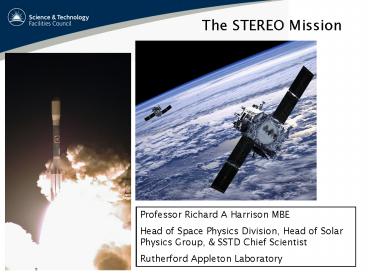Professor Richard A Harrison MBE - PowerPoint PPT Presentation
1 / 27
Title: Professor Richard A Harrison MBE
1
Professor Richard A Harrison MBE Head of Space
Physics Division, Head of Solar Physics Group,
SSTD Chief Scientist Rutherford Appleton
Laboratory
2
UK STEREO Web site www.stereo.rl.ac.uk NASA
STEREO Web site stereo.gsfc.nasa.gov Aberystwyt
h (3D visualisation/modelling) Birmingham
(variable stars, asteroseismology,
exoplanets) Imperial College (heliospheric
structure/activity) MSSL (mass ejection,
cometary structure) Open University (exoplanets,
variable stars) RAL (mass ejection, heliospheric
structure/activity, comet and planetary impacts)
Southampton (heliospheric structure/activity,
planetary impacts) UCLAN (CME propagation) Also
St Andrews, Glasgow ..
3
but they are not coming our way!
4
so, why are we interested? CMEs have never
been imaged along the Sun-Earth line
5
so, why are we interested? The structure of
the inner heliosphere has never been imaged
6
(No Transcript)
7
Where are we now? Dec 6 2007 Separation
angles AB 42.3 deg A/Earth 20.8 deg B/Earth
21.5 deg Drift 22 deg/year
8
Radiator
HI-1
Door
Side rear baffles
Door latch mechanism
HI-2
HI instrument description Harrison,
Davis, Eyles, Advances in Space Res. 36, 1512,
2005
Inner Baffles
Forward Baffles
Direction of Sunlight
Concept Wide-angle imager with occultation
baffle system light rejection of 3 x 10-13
10-14 of the Solar Brightness, for the two
telescopes.
9
(No Transcript)
10
(No Transcript)
11
First CME tracked through inner heliosphere
Harrison, Davis, Eyles et al., 2007, Solar Phys.
in press.
12
V 550 km/s deceleration? Tracked to 32o
- First mapping of F-corona to tens of degrees
from Sun 1.25 x 10-11 1.7 x 10-13 Bo 4 to
24o compared to Koutchmy Lamy (1985) model
predictions (8 x 10-11 1 x 10-12 Bo) - CME readily extracted to 0.01 of F-coronal
intensity demonstrated ability to track/map
CMEs to Earth
Harrison, Davis, Eyles et al., 2007, Solar Phys.
in press.
13
(No Transcript)
14
- The physics of CME impacts
- Speed, direction, density, magnetic structure of
ejecta - Passage through events
- Nature of the background heliosphere
- Evolution of ejecta reconnection, pile-up etc
- 3-D mapping? Looking at the 3rd dimension
- In-situ ground-truths e.g. at Earth, at
Venus, Ulysses etc - On all Solar System bodies!
15
Davies, Rouillard, Harrison et al. 2007,
submitted Geophys. Research Lett. (Southampton,
RAL)
16
Rouillard, Davies et al. submitted Geophys.
Research Lett. (Southampton, RAL)
17
Comet McNaught January 2007
Discovery of atomic iron in McNaught comet tail
using HI Fulle, Leblanc, Harrison, Davis, Eyles
et al., 2007, Astrophys. Journal 661, L93
(Italy, RAL, Birmingham)
18
Comet McNaught January 2007
Discovery of atomic iron in McNaught comet tail
using HI Fulle, Leblanc, Harrison, Davis, Eyles
et al., 2007, Astrophys. Journal 661, L93
(Italy, RAL, Birmingham)
19
Comet Encke April 2007 A graphic example of
the interaction between solar ejection events and
Solar System bodies driven by magnetic
reconnection
First direct observation of comet tail
disconnection due to CME
Vourlidas, Davis, Eyles, Crothers, Harrison,
Howard, Moses, Socker, 2007, Astrophys. Journal
668, L79 - (RAL, Birmingham, USA)
20
Stellar Variability Exoplanets, variable stars,
asteroseismology Open University Birmingham
University
White, Bewsher et al. work in process (Open
University, RAL) Also Chaplin et al. (Birmingham)
21
its not flat!
22
(No Transcript)
23
(No Transcript)
24
(No Transcript)
25
(No Transcript)
26
(No Transcript)
27
(No Transcript)































